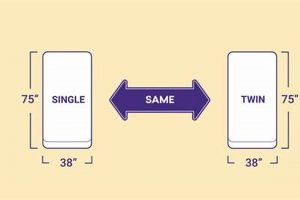The dimensional contrast between a smaller single bed and a larger standard double bed is significant. One typically measures around 38 inches wide and 75 inches long, while the other provides approximately 53 inches in width and 75 inches in length. This difference in surface area directly impacts suitability for various users and spatial constraints.
This choice is a crucial consideration when furnishing bedrooms, guest rooms, or dormitories. Selecting the appropriate dimension contributes to sleep quality and overall room functionality. Historically, space limitations often dictated the selection of the smaller option, while the larger option became associated with increased personal comfort and the accommodation of multiple occupants.
Therefore, an examination of these distinct measurements, considering individual needs, room size, and anticipated usage patterns, is warranted to facilitate an informed decision regarding the optimal bed size for a given application. Key aspects to consider are the dimensions, suitability for different sleepers, room placement, and cost implications.
Considerations for Choosing Between a Smaller Single and a Standard Double Bed
The selection between a smaller single bed and a standard double bed necessitates careful consideration of individual requirements and spatial constraints. The following guidelines aid in making an informed decision.
Tip 1: Evaluate Occupant Size and Sleeping Habits: Assess the height and sleeping habits of the intended user. Taller individuals or those who move frequently during sleep may benefit from the additional width offered by the larger mattress.
Tip 2: Measure Available Room Space: Accurately measure the dimensions of the room where the bed will be placed. Ensure sufficient space for movement around the bed and other furniture. A standard double bed may overcrowd smaller rooms.
Tip 3: Assess Budgetary Constraints: Recognize that the larger mattress, along with associated bedding, will typically incur a higher cost than its smaller counterpart. Factor this into the overall budgetary plan.
Tip 4: Consider Room Aesthetics: Contemplate the visual impact of each mattress size on the overall room design. A smaller bed may create a more spacious and open feel, while a standard double bed can serve as a focal point in larger rooms.
Tip 5: Anticipate Future Needs: Project potential future requirements, such as accommodating occasional guests or a growing child. If there’s a likelihood of needing more sleeping space in the future, the standard double bed may be a more practical long-term investment.
Tip 6: Assess weight capacity: Be mindful of the weight limit of the bed frame for each mattress. A larger mattress on an incompatible frame can create potential hazards.
Careful evaluation of occupant size, room dimensions, budget, aesthetics, and future needs is crucial when deciding between these two common mattress sizes. Thorough analysis promotes optimal selection that aligns with individual circumstances.
These considerations provide a foundation for exploring specific mattress characteristics, such as firmness and material composition, to further refine the selection process.
1. Dimensions
Dimensional considerations are paramount when differentiating between a smaller single bed and a standard double bed. The specific measurements dictate suitability for various individuals and living spaces, influencing comfort and functionality.
- Width Differences
The primary dimensional disparity lies in width. A smaller single bed typically measures approximately 38 inches wide, while a standard double bed extends to about 53 inches. This 15-inch difference significantly impacts the available sleeping space. For instance, individuals who prefer ample room to move or those of larger build may find the narrower width of the smaller bed restrictive.
- Length Similarities
Both options generally share a similar length, around 75 inches. While this length accommodates most adults, particularly tall individuals should verify that this dimension provides adequate legroom. In situations where space is limited, focusing on the width difference becomes more critical, as length is often a fixed constraint.
- Impact on Room Layout
The footprint of each mattress directly influences room layout and available floor space. The significantly larger width of a standard double bed demands more square footage, potentially limiting furniture placement and overall room maneuverability. In compact apartments or smaller bedrooms, this spatial constraint may favor the selection of the smaller size.
- Weight and Transportation
Dimensions also correlate with weight. The increased surface area of the standard double bed translates to a heavier mattress, potentially complicating transportation and setup. This is a practical consideration for individuals who frequently move or anticipate relocating the bed in the future.
The interplay of width, length, and the resultant footprint is crucial in determining the optimal choice. Careful assessment of individual body size, sleeping habits, and available room dimensions facilitates a well-informed decision.
2. Occupancy
Occupancy, referring to the number of individuals regularly utilizing a bed, is a primary determinant in the suitability assessment of a smaller single bed versus a standard double bed. The intended use case directly informs the necessary sleeping space and comfort level.
- Single Adult Sleepers
For a solitary adult sleeper, a smaller single bed often provides adequate space. It is suitable for individuals who sleep relatively still and do not require substantial width for comfortable rest. However, single adults who are restless sleepers or prefer greater freedom of movement may find the confines of the smaller single bed restrictive, leading to compromised sleep quality. The standard double bed offers ample space for uninhibited movement for the same use case.
- Children and Teenagers
Smaller single beds are frequently employed in children’s and teenagers’ rooms, particularly when space is a premium. The dimensions adequately accommodate the typical size of a child or adolescent, while simultaneously allowing for more play or study area within the room. As the child grows, a transition to a larger bed may be necessary to ensure continued comfort and sufficient space.
- Shared Occupancy Scenarios
Shared occupancy invariably necessitates the selection of a standard double bed or larger. The limited width of the smaller single bed precludes comfortable co-sleeping, regardless of the occupants’ ages or sizes. The standard double bed provides sufficient width to accommodate two individuals, albeit with less personal space compared to larger mattress sizes, such as queen or king.
- Guest Accommodation
In the context of guest rooms, the occupancy pattern dictates the appropriate bed size. If the guest room is intended for single occupants or children, a smaller single bed may suffice. However, for couples or instances where two guests might share a room, a standard double bed provides a more versatile and accommodating option. Providing the adequate occupancy mattress dimensions is essential to ensuring the guests have quality sleeping arrangements.
The intended occupancy pattern, encompassing single sleepers, children, shared usage, and guest accommodation, directly impacts the optimal selection between a smaller single bed and a standard double bed. Careful consideration of these scenarios ensures that the chosen mattress provides adequate space, comfort, and functionality for its intended users.
3. Room Size
The dimensions of a room are a primary determinant in selecting between a smaller single bed and a standard double bed. The available square footage dictates the feasibility and practicality of accommodating each size, influencing not only comfort but also overall room functionality.
- Spatial Constraints in Small Rooms
In confined spaces, a standard double bed may overwhelm the room, restricting movement and limiting furniture arrangement options. A smaller single bed, due to its reduced footprint, allows for greater flexibility in small rooms, preserving valuable floor space and enhancing maneuverability. Examples include studio apartments, small bedrooms in older homes, and shared living spaces where maximizing available area is paramount.
- Optimizing Larger Room Layouts
Conversely, in larger rooms, a smaller single bed may appear disproportionately small, creating an imbalance in the room’s aesthetics. A standard double bed provides a more substantial presence, serving as a focal point and filling the space more effectively. Consider master bedrooms, guest suites, and open-concept living areas where a larger bed complements the overall room scale and design.
- Furniture Placement and Accessibility
The chosen mattress size directly impacts furniture placement and accessibility within the room. A standard double bed requires more clearance around its perimeter, potentially restricting the placement of nightstands, dressers, and other essential furnishings. The more compact dimensions of the smaller single bed offer greater leeway in furniture arrangement, ensuring ease of movement and access throughout the room.
- Visual Balance and Aesthetics
The dimensions of the mattress contribute significantly to the overall visual balance and aesthetics of the room. A standard double bed can create a sense of luxury and spaciousness in larger rooms, while a smaller single bed can promote a minimalist and uncluttered feel in smaller spaces. Consider the desired aesthetic and the existing dcor when determining the optimal mattress size to achieve visual harmony.
The interplay between room dimensions, furniture placement, and desired aesthetics underscores the critical role of room size in selecting between a smaller single bed and a standard double bed. A thorough assessment of the available space and its intended function ensures that the chosen mattress size enhances both comfort and overall room functionality. Consideration must also be given to the remaining elements that complete a rooms features for sleeping and living.
4. Cost
The economic implications constitute a significant factor in the selection process between a smaller single bed and a standard double bed. The initial purchase price, along with associated expenses, varies considerably between the two options, impacting budgetary considerations. The standard double bed typically commands a higher price due to its increased material requirements and larger manufacturing footprint. This price differential extends beyond the mattress itself, encompassing bedding, frames, and related accessories. Consumers must, therefore, account for these added costs when evaluating the overall economic impact.
The long-term cost considerations also warrant scrutiny. While the initial investment for a smaller single bed may be lower, its limited lifespan or suitability for changing needs can lead to premature replacement, incurring additional expenses. Conversely, a standard double bed, while initially more expensive, may offer greater durability and adaptability, potentially proving more cost-effective over time. Furthermore, the energy consumption associated with heating or cooling bedding may differ slightly based on size, contributing to marginal variations in utility costs. The cost differential between the two mattress sizes influences purchasing decisions, particularly among budget-conscious consumers. Families furnishing multiple rooms or individuals facing financial constraints often prioritize affordability, making the smaller option a more viable choice. Conversely, consumers seeking long-term value and prioritizing comfort may find the standard double bed a more justifiable investment.
Ultimately, a thorough cost-benefit analysis, encompassing initial expenses, long-term durability, and suitability for anticipated needs, is essential when choosing between a smaller single bed and a standard double bed. This assessment enables informed decision-making, aligning mattress selection with budgetary constraints and long-term financial planning. Ignoring these costs could potentially lead to poor selection and overspending on a mattress not well suited for your needs. Conversely, careful budgeting allows for improved value and better comfort during sleeping.
5. Durability
Durability, referring to a mattress’s ability to withstand wear and tear over time, exhibits a notable relationship with size selection. The physical stresses exerted on a mattress are often correlated with its dimensions and intended use. The construction materials and design characteristics play a crucial role in determining how well either a smaller single bed or a standard double bed maintains its structural integrity and comfort level throughout its lifespan.
For example, a smaller single bed, primarily intended for single occupancy, may experience less overall weight and stress compared to a standard double bed designed to accommodate two individuals. Consequently, a double bed will require a stronger support system of coils or foam. However, if a smaller single bed is consistently subjected to excessive weight or rough usage, its lifespan may be compromised. A standard double bed, while inherently more durable due to its construction, may degrade more rapidly if exposed to frequent heavy loads, jumping, or improper support from its foundation.
Selecting a mattress involves a consideration of both size and intended usage to optimize durability. Investing in higher-quality materials and construction techniques can mitigate the impact of size-related stress factors. Ultimately, the durability of either mattress size depends on a combination of conscientious usage and appropriate material selection to meet the specific demands of its intended application, resulting in better value for money.
6. Frame Compatibility
Frame compatibility is a non-negotiable factor when selecting a mattress. Discrepancies between mattress dimensions and frame size can compromise support, accelerate mattress wear, and even pose safety risks. The correlation between frame and mattress size, specifically when deciding between a smaller single bed and a standard double bed, necessitates careful consideration.
- Standard Dimensions and Frame Design
Mattress and frame manufacturers adhere to standardized dimensions. A smaller single bed requires a frame engineered for 38″ x 75″ dimensions, while a standard double bed necessitates a 53″ x 75″ frame. Deviating from these standards results in inadequate support, mattress overhang, or inability to properly fit the mattress.
- Support Structures and Weight Distribution
Frames are designed with specific support structures, such as slats or metal grids, to distribute weight evenly across the mattress. Using a frame designed for a smaller mattress with a larger, heavier mattress can overload the support system, leading to premature frame failure and uneven mattress wear.
- Headboard and Footboard Integration
Headboard and footboard designs are often integrated with the frame to provide aesthetic appeal and structural stability. Mismatched mattress and frame sizes can disrupt this integration, resulting in gaps, misalignment, and a compromised aesthetic. In some cases, attempting to force a mismatched fit can damage the frame or headboard.
- Bedding and Accessory Considerations
Frame compatibility extends to bedding and accessories. Ill-fitting sheets, comforters, and bed skirts can result from dimensional mismatches, detracting from both comfort and visual appeal. In extreme cases, incompatible bedding can exacerbate existing support issues.
The choice between a smaller single bed and a standard double bed is inextricably linked to frame compatibility. Thorough verification of dimensions and support capabilities ensures optimal mattress performance, longevity, and user safety.
Frequently Asked Questions
The following addresses common inquiries regarding the distinctions between smaller single beds and standard double beds, focusing on practical considerations for informed decision-making.
Question 1: Is a smaller single bed suitable for adults?
A smaller single bed can accommodate adults, provided they do not require substantial sleeping space or exhibit restless sleeping habits. Taller individuals or those who prefer ample room to move should consider the larger dimensions of a standard double bed for enhanced comfort.
Question 2: How does the selection between a smaller single bed and a standard double bed affect room dcor?
The choice between these sizes influences the room’s overall aesthetic. A standard double bed can serve as a focal point in larger rooms, while a smaller single bed often creates a more spacious and minimalist feel in compact spaces.
Question 3: What are the budgetary considerations when choosing between a smaller single bed and a standard double bed?
A standard double bed and its associated bedding typically incur a higher cost than a smaller single bed. Budgetary constraints are critical factors, particularly for individuals furnishing multiple rooms or facing financial limitations. These costs may also include frames or bedding associated with either choice.
Question 4: How do sleeping habits affect the choice between a smaller single bed and a standard double bed?
Individuals who move frequently during sleep or prefer a greater range of motion generally benefit from the increased width provided by a standard double bed. Restricted movement on a smaller single bed may compromise sleep quality.
Question 5: Can a standard double bed fit into a small bedroom?
While physically possible, a standard double bed may overcrowd a small bedroom, limiting movement and furniture placement options. Careful measurement and spatial planning are essential to ensure functionality and comfort.
Question 6: Is frame compatibility a significant factor when selecting between a smaller single bed and a standard double bed?
Frame compatibility is critical. Each mattress dimension requires a correspondingly sized frame to ensure proper support, weight distribution, and mattress longevity. Mismatched frames can lead to accelerated mattress wear and potential safety hazards.
In summation, selecting between a smaller single bed and a standard double bed requires careful consideration of individual needs, spatial constraints, budgetary limitations, and anticipated usage patterns. A thorough assessment of these factors ensures a well-informed decision that optimizes both comfort and functionality.
These FAQs provide a solid foundation for understanding key distinctions and are useful for additional exploration of specific mattress characteristics and related accessories.
Conclusion
The preceding analysis has systematically explored the principal distinctions between the dimensional standards and practical considerations associated with a smaller single bed and a standard double bed. Key factors examined include spatial requirements, intended occupancy, economic implications, and durability considerations. Variations in these aspects directly influence the appropriateness of each option for specific applications and individual requirements.
Therefore, prospective purchasers should carefully evaluate all relevant factors before deciding. An informed selection, predicated on a comprehensive understanding of the dimensional variances and associated implications, ensures the optimized utilization of resources, the enhancement of sleep quality, and the avoidance of future inconveniences. Future research may focus on the integration of ergonomic data to further refine mattress selection methodologies.







![Bear vs Saatva Mattress: Which Bed is Best [Review]? Organic & Natural Mattress Buyer’s Guide: Non-Toxic Sleep Solutions Bear vs Saatva Mattress: Which Bed is Best [Review]? | Organic & Natural Mattress Buyer’s Guide: Non-Toxic Sleep Solutions](https://mattressworldpa.com/wp-content/uploads/2025/07/th-1052-300x200.jpg)